
Creskeld Hall is a grade II listed [1] Country House located in Arthington, near Otley, West Yorkshire, England.

Creskeld Hall is a grade II listed [1] Country House located in Arthington, near Otley, West Yorkshire, England.
The place-name is first attested in the twelfth century, as Creskeld and Creskelde. The name comes from the Old English words cresse ('cress') and kelde ('spring, well', itself a borrowing of Old Norse kelda). Thus the name once meant 'spring with cress growing nearby'. The place-name thus suggests that the settlement dates back to before the Norman Conquest of England. [2] A spring of fresh water flows past the Hall all year round; and watercress grows in abundance in the streams and water gardens.
In 1189, Hugo de Creskeld gave all his land at Creskeld with an annual rent of 6d and a common pasture of 260 sheep to Kirkstall Abbey. A chapel was attached to the house before the end of the 12th century. The Manor House was leased to Sir Richard de Goldsbro and in 1352 a deed was executed between Sir Richard de Goldsboro and Robert Tottie relating to the granting of Creskeld wood for the smelting of iron. This deed is said to be the oldest deed relating to that industry now in existence.
At the dissolution of the Monasteries, the Manor of Creskeld passed into the hands of Thomas Cranmer, a nephew of the famous Archbishop Cranmer. In 1596 the Wentworth family from Wakefield occupied the Hall and rented it for £15 a year. In 1660, it was inherited by Evelild, the eldest daughter of George Wentworth, who was the wife of John Thornhill of Fixby.
In 1846, Francis Rhodes [3] of Bramhope Hall, the next door estate, married the only child of the owner of the Hall Charlotte Maria Cooper Darwin. He assumed her surname and arms in 1850 upon inheritance of Elston Hall from Robert Alvey Darwin [4] and they took up residence at Creskeld Hall. [5] The estate thus came into the ownership of the Rhodes family, who had been in Wharfedale for many centuries.
Francis (Rhodes) Darwin was born in 1825. He became a barrister, then a magistrate and was Chairman of the Highways Committee and Alderman of the new West Riding of Yorkshire County Council for more than 50 years. He died in 1918 at the age of 93.
The present Hall at Creskeld occupies the site of the original Manor house and there are parts in the centre which date back to the 1600s, with very old oak beams. Much of the rest of the building was built between 1850 and 1920 and includes a chapel room that was rebuilt after a fire in 1870. This was never re-consecrated and is now part of the main house. A flat-roofed billiard room extension was added in 1919. This connects the rebuilt chapel with the main body of the house, and has enclosed a courtyard where the front entrance used to be.
The Hall has been privately owned by the same family since 1919 being purchased by Bertram Parkinson, the grandfather of the current owners. It was then the home of Colonel Sir Malcolm Stoddart-Scott OBE MC TD, Member of Parliament of the local constituency from 1945 until his death in 1973.
Bertram Parkinson founded the Creskeld Herd of British Friesians in 1920, obtaining both a bull and females from a 1922 South African importation and by careful additional purchase accumulated a very good team which won many championships, both pre and post the Second World War. He was President of the British Friesian Cattle Society in 1949. Sir Malcolm Stoddart-Scott continued to develop the herd following Bertram's death in 1953 and had much show ring success in 1966–67 and later. The herd was fully dispersed at a sale in 2013 on the retirement of the Head Herdsman for over 40 years.
The Hall is known to many people as Home Farm from the ITV soap Emmerdale and has been used on the show since the first series commissioned following the pilot series in 1972. Internal scenes have been shot in ITV's Leeds studio since the 1990s and a purpose built facade was used for a short period in 2014 at the Emmerdale village on the Harewood Estate. Over the years the filming of Emmerdale has included memorable scenes such as the 1997 death of David Glover in a fire which was filmed with a temporary structure built on the Hall's billiard room. In 2005 Zoe Tate destroyed the house by setting off a gas explosion which was filmed with the erection of a false facade on the eastern elevation of the Hall.
Creskeld has also been used for other television programmes over the years including, Century Falls, The Attic: The Hiding of Anne Frank, The Darling Buds of May, Anton Mosimann – Naturally, and Secrets of the Royal Kitchen.

The gardens of Creskeld Hall have been open to the public annually for over 10 years as part of the National Gardens Scheme "Yellow Book", [6] with the proceeds being split between the National Garden Scheme, and a charity of the owner's choice. The hall sits in approximately 3.5 acres (14,000 m2) of garden, with a beech tree avenue, and has many rare colours of Rhododendron and Azalea collected by one of the family in the 1930s. The hall was originally part-surrounded by a moat, which is still visible in the garden and the gardens were laid out in various styles from 1825 until 1936, when the water garden was completed for Bertram Parkinson. The grounds also boast a terrace, walled vegetable garden, croquet lawn, canals, woodland plantings, and a specimen of a mature Monkey Puzzle tree.
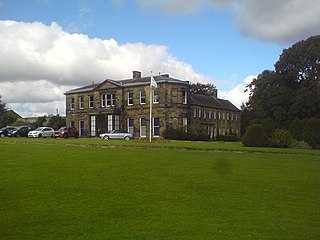
Farnley Hall is a stately home in Farnley, west Leeds, West Yorkshire, England. It is a grade II listed building. It was built in Elizabethan times by the Danbys. The manor is recorded in the 1086 Domesday Book as Fernelei, so it is probable that this house was a replacement for earlier medieval structures.

Arthington is a small village in Wharfedale, in the City of Leeds metropolitan borough in West Yorkshire, England. It is a civil parish which, according to the 2011 census, had a population of 532 and is in the LS21 postcode district with Otley as its post town. It is in the Otley ward of the City of Leeds, and the Leeds North West parliamentary constituency.

Ilam is a village in the Staffordshire Peak District of England, lying on the River Manifold. The population of the civil parish as taken at the 2011 census was 402.
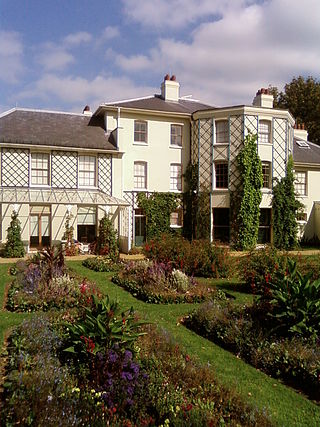
Down House is the former home of the English naturalist Charles Darwin and his family. It was in this house and garden that Darwin worked on his theory of evolution by natural selection, which he had conceived in London before moving to Down.

Bramhope is a village and civil parish in the City of Leeds metropolitan borough, West Yorkshire, England, north of Holt Park and north east of Cookridge.

Tabley House is an English country house in Tabley Inferior, some 3 kilometres (1.9 mi) to the west of the town of Knutsford, Cheshire. The house is recorded in the National Heritage List for England as a designated Grade I listed building. It was built between 1761 and 1769 for Sir Peter Byrne Leicester, to replace the nearby Tabley Old Hall, and was designed by John Carr. The Tabley House Collection exists as an exhibition showcased by the University of Manchester.

Sir Reginald Theodore Blomfield was a prolific British architect, garden designer and author of the Victorian and Edwardian period.

Clevedon Court is a manor house on Court Hill in Clevedon, North Somerset, England, dating from the early 14th century. It is owned by the National Trust and is designated as a Grade I listed building.

Kentwell Hall is a stately home in Long Melford, Suffolk, England. It includes the hall, outbuildings, a rare-breeds farm and gardens. Most of the current building facade dates from the mid-16th century, but the origins of Kentwell are much earlier, with references in the Domesday Book of 1086.

Arthington Priory was an English monastery which was home to a community of nuns in Arthington, West Yorkshire, founded in the mid-12th century. The priory land is occupied by a residence called "Arthington Hall", which was built around 1585, and little, if anything, remains of the priory. The site of the priory church is possibly now occupied by a farmhouse called The Nunnery. The community was the only one of nuns of the Cluniac congregation in Yorkshire and one of two in England. It was established through a grant by Peter de Arthington.

Bretherton is a small village and civil parish in the Borough of Chorley, Lancashire, England, situated to the south west of Leyland and east of Tarleton. The population of the civil parish at the 2011 census was 669. Its name suggests pre-conquest origins and its early history was closely involved with the manor house Bank Hall and the families who lived there. Bretherton remained a rural community and today is largely residential with residents commuting to nearby towns.
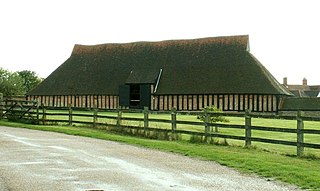
Cressing Temple is a medieval site situated between Witham and Braintree in Essex, close to the villages of Cressing and White Notley. It was amongst the very earliest and largest of the possessions of the Knights Templar in England, and is currently open to the public as a visitor attraction.
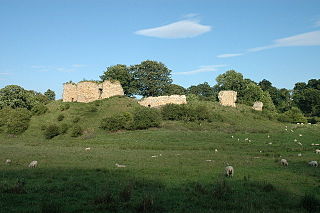
Mitford Castle is an English castle dating from the end of the 11th century and located at Mitford, Northumberland. It is a Scheduled Ancient Monument and a Grade I listed building, enlisted on 20 October 1969. The castle is also officially on the Buildings at Risk Register. The Norman motte and bailey castle stands on a small prominence, a somewhat elliptical mound, above the River Wansbeck. The selected building site allowed for the natural hill to be scarped and ditched, producing the motte.

The Worsley family is an English family that is derived from Sir Elias de Workesley, a Norman knight who was a youth at the time of the Norman conquest. He later accompanied Duke Robert II of Normandy on the First Crusade and was buried at Rhodes.

Lytes Cary is a manor house with associated chapel and gardens near Charlton Mackrell and Somerton in Somerset, England. The property, owned by the National Trust, has parts dating to the 14th century, with other sections dating to the 15th, 16th, 18th, and 20th centuries. "Yet all parts blend to perfection with one another and with the gentle sunny landscape that surrounds them," comments Nikolaus Pevsner. The House is listed as Grade I by English Heritage.
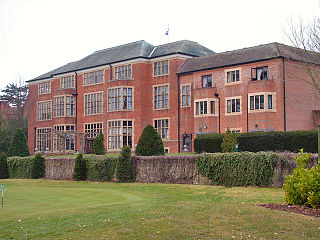
Hanbury Manor, centred on the multi-wing Hanbury Manor Hotel, is a converted late-Victorian country house and adjoining golf course in Thundridge, north of Ware, Hertfordshire, some 10 miles (16 km) north of Greater London. It is part of a leisure retreat and country club owned by Marriott Hotels. The house is Grade II* listed on the National Heritage List for England.

Eccup is a village in the civil parish of Alwoodley and north of the City of Leeds, West Yorkshire, England. It is just north of Alwoodley and east of Bramhope and Golden Acre Park. Eccup is at the north-west edge of Eccup Reservoir.

Lichfield Court, in Richmond, London, consists of two Grade II listed purpose-built blocks of flats. Designed by Bertram Carter and built in fine Streamline Moderne style, it was completed in 1935.

Bramhope Tunnel is on the Harrogate Line between Horsforth station and the Arthington Viaduct in West Yorkshire, England. Services through the railway tunnel are operated mainly by Northern. The tunnel was constructed during 1845–1849 by the Leeds and Thirsk Railway. It is notable for its 2.138-mile (3.441 km) length and its Grade II listed, crenellated north portal. The deaths of 24 men who were killed during its construction are commemorated in Otley churchyard by a monument that is a replica of the tunnel's north portal.

Widford is an area of Chelmsford and former civil parish, now in the unparished area of Chelmsford, in the Chelmsford district, in the county of Essex, England. It is approximately 1.5 miles (2.4 km) south-south-west of the city's railway station. It encloses a mixed residential, industrial and rural area south of the River Can, east of the River Wid and mostly to the west of the Great Eastern Main Line. In 1931 the parish had a population of 457.